#human osteology
Explore tagged Tumblr posts
Text
Nutrient Foramen of Femur
Found around the midshaft level
On posterior level
Next to or on the linea aspera
Exits bone distally

Patreon
#studyblr#notes#my notes#anthropology#biological anthropology#bioanthropology#bioanthro#bioanth#bio-anthropology#human biology#human osteology#biology#bio#osteology#osteological analysis#skeletal system#forensics#forensic anthropology#human bones#bones#forensic science#science#bone analysis#human identification#bioarchaeology#bioarcheology#archaeology#archeology#biological science#life science
4 notes
·
View notes
Text
i was not made to sit in a vape shop for 6-7 hours a day being incredibly bored and understimulated.
i was made to work in a zooarchaeology and/or osteology lab at a university where i don't have to worry about being bored or over/understimulated or dealing with customers. can someone Please give me a pile of bones and pay me to catalog them. and/or money for grad school
#sighs#i hate retail it's so soul sucking#this is not what i was meant to do!!!#this is not what life is about!!!!#life is about discovery and happiness#i'm achieving neither by sitting in a fucking vape shop that barely makes $1k a day#adams tape#osteology#zooarchaeology#human osteology#archaeology#anthropology#biological anthropology
2 notes
·
View notes
Text
Ethics and Ownership of Human Remains
This is an excerpt from a essay on the ethics of private ownership of human remains not for educational, conservation ship, or cultural practices.
The ethical dilemmas surrounding ownership of human remains primarily stem from the lack of informed consent and the exploitation of marginalized communities. Remains were collected from grave robbing or exploited poor families who could not afford to bury their deceased loved ones, usually under the guise of scientific inquiry to further our understanding of the human condition (Potter 2023). One major institution, the National Museum of Natural History, holds over 30,000 human remains, many of which lack clear documentation of their origins (Potter 2023). Poor record keeping and high personnel turnover contribute to the difficulty of addressing the origins of these remains, complicating efforts to ensure ethical stewardship (Licata et al. 2020).
While some of these specimens can be repatriated to living descendants through the Native American Graves Protection and Repatriation Act (NAGPRA), others, regardless of ancestry, will eventually be de-accessioned from institutions and change ownership through various means. For those who do not want skeletal specimens second hand, a thriving online market persists. Websites like Skulls Unlimited and JonsBones will sell to anyone while other platforms like eBay and Instagram host anonymous sales or advertisements of online stores to buy skeletal material, ranging from teaching specimens to “tribal” artifacts (Licata et al. 2020). Skulls Unlimited claims “commitment to ethical sourcing” but does not specify if this applies to their human or animal collections and does not go into further detail on their products’ respective pages. JonsBones admonishes the notion of ethical sourcing as being too vague of a concept, so they invented their own vague concept of “responsible sourcing”. It is somehow better because “our bones are certified bones from the medical trade.” (Ferry, Jon). If this is the same “medical trade” that benefited from 18th and 19th century antiquarianism, grave robbing, and before India’s ban of trading human remains is unclear.
What happens to these remains once in the hands of private ownership is dubious at best. Some people collect “oddities” that range from skeletal remains belonging to humans, non-humans, to the stereotypical specimen in a jar of formaldehyde for their display. This ethically dubious enterprise does not stop at home and office décor. Simply searching the terms “real human bone jewelry” or a similar combination, will lead to online stores selling such items. Curiosities from the 5th Corner, sells a variety of items made from modified human remains, allegedly from remains “over 100 years old”. However, if institutions like the National Museum of Natural History or numerous universities have trouble keeping track of their specimens’ provenance, why should I trust this website? Not to mention remains this old, if they are, should be in an archaeological collection supervised and conserved by competent professionals educated and trained to do so.
There is no shortage of cadaver capers. Southern Nevada Donor Services offers free cremation for families in exchange for donating their deceased loved one under the guise of “advanced medical studies.” However, in 2015 complaints of smells, bloody boxes in dumpsters, and one employee thawing out a frozen human torso with a garden hose (Grow and Shiffman, 2017) reveals the heinous origin of some of these contemporary skeletons.
A recurring theme of apathy stands at the forefront of this issue. These sellers all push a specific narrative to justify their businesses. Curiosities from the 5th Corner responds to the question of if this practice is disrespectful with: “My personal opinion is that you can only disrespect the living.” I find this disingenuous as with the rest of the FAQ this quote is taken from. A similar store, Death Isn’t the End, discusses the origin of their skeletons and other opinions; “I have come across skulls over the years that have been grossly mistreated and damaged, whether it be from accidental drops, occult type ceremony or even malicious intent. These pieces are sometimes very old or some are new and vary in history from museum or private collections to medical schools or colleges and high school science classes and they always made me sad for the destruction of a wonderful thing and for the disrespect of the person it once was.” Somehow creating jewelry from these acquired specimens isn’t a destructive nor disrespectful process, but the most revealing and audacious quote in their about me page is: “I felt that I had found a way to take this neglected and broken skull and give it back respect.”
JonsBones takes this presumptuous attitude farther by disguising their enterprise as educational and equitable because “not everyone has the same access to museums, medical collections, or artifacts that explain and cultivate the science behind bones” and “we actively bridge the gap between the anthropological community and the general public to make osteology more approachable.” The applied anthropological thing to do, in my undergrad opinion, is to indeed give equitable access. However, JonsBones is a store that sells items at price tags equitable only to the wealthy, a demographic that has no shortage of educational access. Certainly, with the profits gained from sales of these items and admission to The Bone Museum, JonsBones could donate to chronically underfunded school districts or fund scholarships for students pursuing biological anthropology, forensics, and fields that utilize human osteology. Unfortunately, this will not happen because it is more profitable to sell and display “responsibly sourced” human remains.
To respond to Curiosities from the 5th Corner’s opinion, this does disrespect the living. It disrespects living descendants, marginalized populations, and continues to feed a market with already dubious tactics and precarious origins as discussed previously. In a majority capitalist world that pushes boundaries in the pursuit of profit with little to no oversight, the commodification of the human body will not stop with one’s bones at the end of a natural lifespan. This fact has already played out historically with the 19th century duo William Burke and William Hare who murdered an estimated sixteen people to sell their bodies to Dr. Robert Knox’s anatomy school (University of Edinburgh).
Licata, Marta et al. “Study, conservation and exhibition of human remains: the need of a bioethical perspective.” Acta bio-medica : Atenei Parmensis vol. 91,4 e2020110. 7 Oct. 2020, doi:10.23750/abm.v91i4.9674
Potter, Lisa. “Ethical Considerations for Human Remains.” https://attheu.utah.edu, University of Utah, 15 May 2023, https://attheu.utah.edu/facultystaff/ethical-considerations-for-human-remains/.
“Burke and Hare.” The University of Edinburgh, https://medicine-vet-medicine.ed.ac.uk/about/history/burke-and-hare. Accessed 27 Nov. 2024.
#human osteology#osteology#ethics in bio anthropology#anthropology#biological anthropology#ethics in anthropology#thoughts#human bones#research#archaeology#physical anthropology#jonsbones#controversial stuff#nagpra#vulture culture#bones
0 notes
Note
It is so interesting to hear from someone who has expertise in this field. I often get frustrated by news articles who cherry pick findings and then slap a gender on the remains of a historical figure. In hindsight, I should have been more clear on my frustrations. But I thank you so much for enlightening me on this subject. I always love to learn new things.
why do you think a lot of historians don't think that alexander (and, by extension, other people in history) was gay? sorry if this is worded strangely by the way
Anon I’m not yelling at you I love you but I have to yell because everyone on tumblr spreads such bad misinformation. NO HISTORIANS THINK ALEXANDER WAS STRAIGHT. NOR ANY OTHER OLD TIME GAYS. LITERALLY NONE. THIS IS A MYTH PERPETUATED ON TUMBLR AND IT ISNT REAL STOP BELIEVING IT IM LOSING MY MIND !!!!!!!!!!!!!!!!!!!!!!!
Okay. Now that I am. Calm. Sorry. Even tho plenty of historians were homophobic back in like last century — no one currently writing, period — they still could not DENY that Alexander who kept a MALE CONCUBINE , FUCKED MEN. Even the MOST homophobic ones were like “it was his worst vice” but they couldn’t DENY it. NOBODY EVER sorry normal volume nobody ever denied it in the whole history of the world never. Never. No one. That is fake. People who say that do not know what they are talking about.
On the OTHER hand , historians will say that for example Hamilton was “straight” because there IS NO DEFINITIVE EVIDENCE OTHERWISE. no, a few gay letters are not hard evidence. YES, male friendship mores were WAY DIFFERENT in old times, and it’s WAY too much extrapolation to assume from a few gay sounding TO US letters that he was fucking that twink Laurens. That is BAD METHODOLOGY. that is not homophobic it is BAD METHODOLOGY. you cannot publish that kind of thing cuz it’s simply not got enough evidence. I don’t care if they probably were, there is EMPIRICALLY NOT ENOUGH EVIDENCE.
Okay. Also. Last point. l hate the misinformation on this hell site. Last point.
Gay and straight were not labels that existed until the late 1800s. Historians do not write about sexuality in terms of gay and straight because gay and straight did not exist as we know them to people prior to the late 1800s. We can only judge how people in history had sex based on their actions. If a historian says Alexander wasn’t gay or bi it isn’t because they’re saying he didn’t fuck men. It’s because they’re saying it’s extremely reductive and bad scholarship to ascribe modern definitions of sexuality and modern sexual mores to the ancient world. When we’re just hanging out and talking one on one or casually, no problem saying gay and straight! It helps us conceptialize how they lived! It’s something we understand. But in a PAPER you are trying to PUBLISH, you CANNOT say that because it misinterprets the workings of their society.
Okay. Thank you. I hope this clears things up for every dumbass who makes those posts and misinforms my innocent fellow classics people who are new and do not know. I hate y’all. Not you anon. Y’all who peddle this ….. homophobia nonsense. Stop it
3K notes
·
View notes
Text
Just saw this poll and as an archaeologist I've touched some old shit, but I've also held human remains and I only just now realized that might not be common so:
(im thinking urn doesn't count, sticking your hand in the ashes does)
#rrrambles#my polls#tumblr poll#poll#tumblr polls#random polls#polls#human remains#skeletons#archaeology#osteology#history
25 notes
·
View notes
Text
So I’m going to highlight something I’m not sure people who like skeletons and curiosities think about often:
the human skeletal remains you see for sale in oddities shops were invariably grave-robbed.
I worked with human remains in an academic research context in the US for more than a decade. One of the first things I tried to teach my students was respect for the remains in our collections, not only because they were people, deserving of dignity in their death, but also because most of the skeletal remains in academic teaching collections were not donated voluntarily. In most cases, we have no idea exactly where they came from or to whom they belonged.
Historically, there has been a huge international trade in human skeletal remains for teaching medical students. The trade reached its peak in the 19th Century and continued for much of the 20th, and while ostensibly the practice was banned in India in 1985, it does still exist illegally. In the US and Europe, most of the remains in teaching collections were sourced from India through bone traders. Bone traders were (are) lower caste people charged with disposing of human remains—often by cremation, but also by interring in graves—but instead of doing so, sold the remains on to medical schools in the US/Europe through the intermediary of anatomical and medical supply companies. These anatomical specimens are the remains of people who were, unknowingly and without consent of their loved ones, denied their humanity in death to satisfy the appetite of the West for anatomical specimens, despite the remains of their own people being considered largely sacrosanct.
Which leads me to my next point: this practice originated under British Colonialism in India. I hope I don’t need to draw this point out, but objectification of these remains by medical students and researchers is a furtherance of the Western colonial project and othering of people of colour. As medical students, we’re trained to divorce ourselves emotionally from the remains we learn from in the name of professionalism. Medicine can often be confronting, and it serves patients and doctors alike to be able to continue working calmly and objectively in the face of those challenges. But in a world where empires and scientific disciplines have been (and continue to be) built on a legacy of scientific racism and dehumanisation, it behooves us to consider exactly how those teaching specimens were acquired—and how they came to be for sale.
Any human skeleton or human bones you see for sale in oddity stores are invariably retired teaching specimens, or were otherwise originally purchased through an anatomical specimen supply company that leveraged bone traders for acquiring their wares. In other words, those remains were grave-robbed, or stolen from funeral pyres and morgues. It is vanishingly unlikely that they are remains of known, ethically-sourced provenance like informed donation. If they were, they would not have been relinquished to the general public to be sold for profit. There would be contractual obligations that dictate how those remains would be managed once they need to be retired from teaching/decommissioned.
Please keep this in mind when you see human remains for sale in oddity shops. Buy plastic or ceramic teaching models instead. Don’t unwittingly continue creating a market for stolen human remains.
#personal#if you’re wondering what should be done with the remains if we can’t teach with them the answer is inter and memorialise them#universities and medical schools need to make a concerted effort to shift their reliance on these remains towards intentionally constructed#teaching collections of known and ethical provenance#this is a hugely expensive time-consuming and complicated enterprise#but to be honest I’m not sure I like what it says about most institutions that theyd want to do it on the cheap#I also did a lot of work back in the day in repatriation of indigenous remains in museum contexts and I will tell you:#if the institution can’t tell you where they came from or to whom the remains belonged#they likely aren’t there voluntarily#medicine#human skeleton#anatomical specimens#oddities#scientific racism#Calcutta bone trade#osteology#anatomy#anatomical study
8 notes
·
View notes
Text
finals need to end so i can stop focusing on rubidium-strontium dating of pottery used to store fucking pearl millet in 250 bc or indulging my professors incrediblyyyy freudian interpretations of monumental architecture or something when i suddenly have artistic motivation the likes of which i haven't experienced since like 2019.
#although radiometric dating is very fun i just don't care about ancient grain crops all the much im sorry#i wanna do biological / forensic anthropology and unfortunately i have a hard time forcing myself to care about tuber cultivation#my professor thinks a lot of things are penis shaped when they really aren't#like i think it says more about you that you're interpreting this stone monument as a giant penis than it does the monument itself#next semester save me#anatomy osteology bio of human sex behavior medical anthropology#finally something that's gonna interest my brain and make me enjoy studying until 4 am#dreams of forensics and paleopathology#and also deep regret of not double majoring in clinical lab science#oh well if i don't fuck up the next 3 semesters maybe they'll let me into anatomical science grad program pretty please
5 notes
·
View notes
Text






Love being an archaeologist
#archaeology#student#university#dark acadamia aesthetic#ethel cain#inspired#human anatomy#skeletons#osteology
31 notes
·
View notes
Text
*supersonic shrieking*
#forensic anthropology#osteology#skeletons#human remains#animal remains#human identification#animal identification#forensic archaeology#crime scene#investigations#bones
3 notes
·
View notes
Text
Human Osteology Introduction
#MendelsLaws#HereditaryTraits#ScienceOfInheritance#MendelianInheritance#GeneticDiscoveries#BiologyLessons#MendelsPrinciples#GeneticsEducation#HereditaryScience#Human Osteology Introduction
2 notes
·
View notes
Text
The hyoid bone is the only bone not attached to another bone.
#studyblr#notes#my notes#anthropology#biological anthropology#bioanthropology#bioanthro#bioanth#bio-anthropology#human biology#human osteology#biology#bio#osteology#osteological analysis#skeletal system#forensics#forensic anthropology#human bones#bones#forensic science#science#bone analysis#human identification#bioarchaeology#bioarcheology#archaeology#archeology#biological science#life science
18 notes
·
View notes
Text
Skulls and Bones Procreate Brush Set - 34 Pieces
34 piece Skulls & Bones Procreate Stamp Set! Use alone or with my other stamp sets to create unique illustrations and compositions! I use my stamp packs to build the bases of my illustrations and the tattoo designs I create.
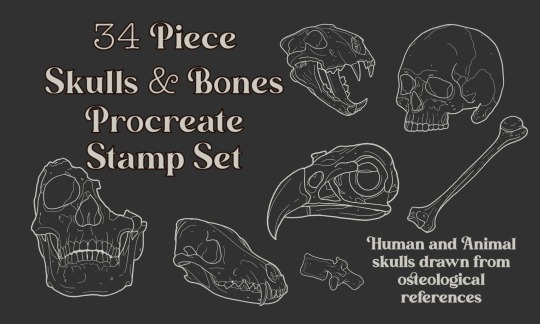
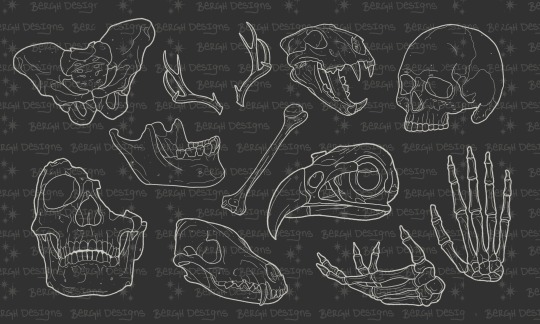
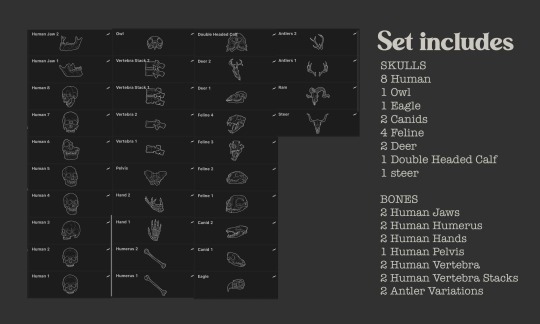
Set includes both human and animal skull stamps drawn from osteological references.
Skulls include:
8 Human skulls
1 Owl skull
1 Eagle skull
2 Canid (dog) skulls
4 Feline (cat) skulls
2 Deer skulls
1 Double Headed Calf Skull
1 Steer Skull
1 Ram Skull (not in list above, I just forgot it)
Bones include:
2 Human jaws
2 Human Humerus (thigh bones)
2 Human hands
1 Human pelvis
2 Human vertebra variations
2 Human vertebra types
2 Antler variations
These stamps can be used for personal or commercial purposes, however any piece of this set, or this set as a whole, cannot be shared, duplicated, or redistributed in any way.
Set comes as single procreate brush file for download immediately after purchase.
Due to the digital nature of this product, no returns or refunds will be accepted or issued, respectively.
Happy Creating!
PRODUCT LINK: https://alexisbergh.gumroad.com/l/skullsandbones
#procreate#procreate stamp#procreate stamp pack#procreate stamp set#procreate brushes#procreate brush set#digital design#digital illustration#digital art#digital artist#digital download#gumroad#skulls and bones#animal skulls#human skull#human bones#osteology#independent artist
8 notes
·
View notes
Text
guys I’m taking human anatomy rn I feel so Dr Tenma 😆😆
jokes aside tho it’s so fucking cool… legit resurfaced my hyper fixation on the skeletal system bc I LOVE BONES! YEAH!
#dr tenma core#human anatomy is so fascinating#can’t wait for physiology bc that sounds hella cool too#now I’m a bit conflicted…#osteology or cardiology.#big question#but we’ll find out ig#not looking too forward to the musculatory system on monday tho#but hey cardiovascular is after sooo#n then nervous system! twinning w tenma 😍😍
2 notes
·
View notes
Text

Geriatric human skull. Victorian era based on hardware.
0 notes
Text
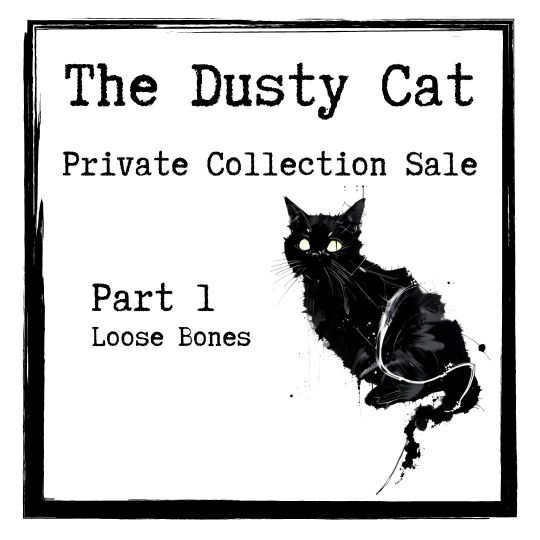
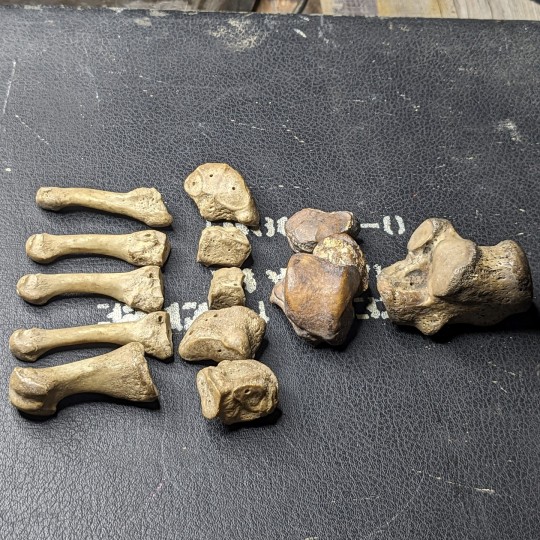
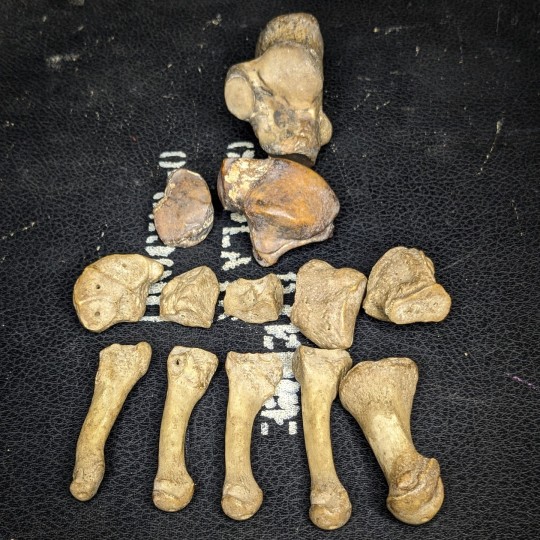
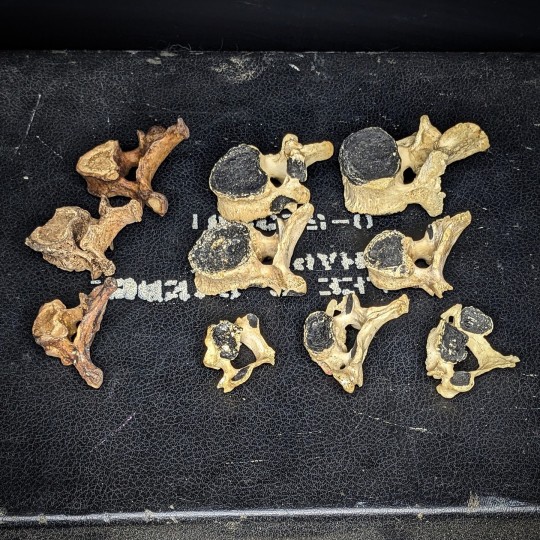
I took a short break from social media for my mental health, but I'm looking at $4k worth of medical bills so I'm going to start dipping into my collection and posting items for sale to help with that. Just in time for early Holiday shopping if you have friends or family with good taste 😀
Starting off with a loose collection of 13 foot bones and a loose collection of 10 vertebrae.
Neither set appears to be from a single respective specimen.
Foot bones - $250 shipped Vertebrae - $280 shipped
DM if interested.
Sales will go through PayPal. U.S. only. Absolutely no sales to TN, LA, GA.
#obscurities#curiosities#rarities#the dusty cat#cabinet of curiosities#dark interiors#goth aesthetic#skeleton#dark aesthetic#dead things#wunderkammer#human bones#human bones for sale#oddities and curiosities#oddities for sale#curiosities for sale#foot bones#vertebrae#The Dust Cat PCS#osteology#medical education
0 notes
Text
Anytime I see a UFO conspiracy theorist get excited about the government being in possession of "non-human remains", as an anthropologist I want to gently sit them down and explain that "non-human remains" is common medicolegal parlance for "animal bones/tissue." "Unidentified non-human remains" just means "it's got characteristics that make it clearly non-human but we haven't sent it to an expert to be formally identified as a pig or deer or part of a coyote just yet."
Animal remains get mistaken for human and turned over to authorities all the time by people not trained in osteology. Sometimes the bones look close-ish enough to human that the mistake is understandable (bear fore-paws without the claws are famously similar to human hands... which makes a very alarming morning for hikers who find the scattered remnants of a bear that's been field-dressed and skinned). Sometimes the bones are clearly non-human to anyone not hyped up on too much true crime, but they get taken by authorities anyway just to prevent them from being called in again.
Either way, what authorities care about most is clarifying that the remains aren't human (and thus not in need of a death investigation), so once that's established, the label "non-human remains" is applied for inventory purposes. Depending on the agency/circumstances, there may not be any further attempt to identify exactly what kind of animal they're from.
And that's how you can get government records about "non-human remains" being found in the desert near a secretive military base. Aliens didn't crash land, someone out on a hike or a soldier doing a foot patrol or even authorities investigating the crash of a military plane stumbled over some scattered animal bones and either thought they might be human or were under orders to recover anything that could possibly be bone or soft tissue because you always prefer being over-cautious and letting an expert later determine that a bit of bone isn't human over risking leaving any potentially human remains behind.
2K notes
·
View notes